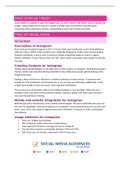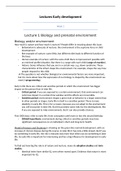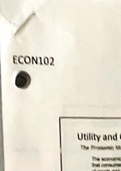The exam consists of open-ended questions (8 or 9) on the material covered in the lectures
and the literature. The objective is that at the end of the course, you have a better
understanding of the psychological mechanisms that according to the scientific literature
underlie many of the social issues that were in diverse societies. Also, you can explain if and
how different theories relate to each other and how they can be used to gain insight into the
issue of cultural diversity. Therefore, questions will mostly be about understanding and not
about reproduction. More concretely, you will be asked to explain your answers or argue why
your answer is the correct one. Given the scientific nature of the programme, the research on
which the theories are based will of course be relevant. In the final question and answer
meeting, example questions will be provided and discussed.
1. Diversity in the Netherlands
Post-war trends in demography of cultural diversity
The Netherlands has been a multicultural society for centuries. After the second world war,
there was migration from the Dutch former colonies (East Indies: today’s Indonesia). After
the war, the Dutch lost the war and Indonesia became independent. And a lot of Indonesians
went to the Netherlands. So there are a lot of immigrants from Indonesia as well as people
from Suriname, Dutch Caribbean...
However, it is only recently that we speak of a multicultural society. It all started with the
guest workers, which we then called Labour migrants, then Immigrants, Ethnic minorities,
Migrants… for a long time we called them Allochthon (allos=different, chtoon=country) and
also called them persons with a migration background. These are all different labels for
basically the same groups, but over time these labels became stigmatized so they changed.
After WW2, and particularly in the 1960s large scale industrialization in the Netherlands,
there was a need for low-skilled workers. Few native Dutch were willing to do this so we
recruited people from other countries like Yugoslavia, Italy, Spain, Portugal and later Turkey
and Morocco. This led to a new phenomenon called “guest workers” (but as the name
suggests, they were supposed to go back). Most of the guest workers did go back but many
from Morocco and Turkey stayed in the Netherlands.
In the 1970s/80s, the Dutch government allowed them to stay and bring over their families.
But the Dutch still thought that it was temporary, but the economy in Turkey and Morocco did
not improve so they stayed permanently. They even were allowed to get partners from
abroad, import marriages.
➔ Definition of
Migrant (CBS):
There are about 4
million people born
abroad (migrants) or
born in the
Netherlands with at
least one parent born
abroad (child of
migrant). So 25% of
the population.
1
,The 2 largest groups of migrants from outside Europe
- Persons with Turkish migration background→2.44%
- Persons with Moroccan migration background→2.38%
They have some characteristics that set them apart from other migration groups in the
Netherlands. They have a culture that is significantly different from Dutch culture.
Another element is that religion differs: they are both Islamic countries and in the
Netherlands this was new. And migrants stay within their culture and within their group.
The migrants continue their culture because it’s easier for them and keep in contact with
their country. Also most Turkish and Moroccan migrants marry within their own ethnic
group (it used to be seeking their partners from abroad but now migration marriages
have gone down because laws have made it difficult). This wouldn’t be a problem if it
weren’t also for an unequal geographical distribution, if they were spread throughout
the Netherlands you wouldn’t notice them but they live concentrated. They concentrate
in the major cities and within those cities they live in specific neighborhoods. We call this
segregation: the concentration of migrant groups within certain neighborhoods, and it’s
very difficult to change. There is also the uneven age distribution, almost half of the
non-western migrants are younger than 20 years. In the Dutch population most people
are very old, but within migrant groups they are young. (In Amsterdam, out of all younger
than 15, more than half are from non-western origin). Migrant mothers have more
children than the Dutch. Another element is that non-western migrants are relatively
poor, they have lower income than western migrants and native Dutch. They also have
high unemployment, also a persistent issue. So when there is an economic/covid crisis,
it’s the Moroccan and Turkish groups that are hit hardest. Poverty will remain because
there is an educational disadvantage, their level is relatively low. A large proportion of
non-western migrants have a lower education.
Post-war trends in social perception of cultural diversity
● Multiculturalism in the 90s
Multiculturalism is the ideology we had in the Netherlands with regards to migrants. There
weren’t protests against migration. And by the time it became apparent that the guest
workers were here to stay permanently, we had a policy called “multiculturalism” based on
the Netherlands being a tolerant society, everyone is welcome and has the right to live here
according to their cultural/religious beliefs and have the right to retain that culture. We accept
cultural diversity even as an enrichment of Dutch culture (like with food). And in terms of
cultural adaptation, the idea was that integration was better than assimilation. Integration
means becoming Dutch but also being Turkish/Moroccan or whatever. And assimilation
2
,means giving up your cultural background to become Dutch. We thought that you can
integrate into Dutch society from the safety of your own cultural background. To stimulate
emancipation (liberation), we would encourage people to set up their own ethnic
organizations and cultural institutions (mosques). And calling ethnicity a problem was taboo
(especially after WW2). And this whole idea of integrating into Dutch society goes back to
pillarization; this is a very traditional Dutch phenomenon that has to do with how different
cultural or religious groups live with each other. In the Netherlands we have pillars, which are
sub-societies within the larger society formed around an ideology or religion (protestant
people lived together and had their own pillar, as well as catholic, etc. where they go to
catholic stores, married catholic and didn’t have to engage with other pillars). And at the top
of those pillars was the parliament consisting of representatives of all pillars and had to find
consensus and negotiate a compromise. This pillarization worked really well in the
Netherlands. So they thought, why not have a migrant pillar? with their own organizations so
they can be happy. So in order to deal with the challenge of the large influx of migrants, we
adopted the pillarization model and multiculturalism model, which in general worked fine.
But there were some things lingering beneath the surface, a report on research in 1998 into
unease among the Dutch population about multicultural society collected data on what native
Dutch thought about Turkish/Moroccan immigrants. They found that there was a significant
amount of people that thought these immigrants were dishonest, selfish, not law abiding,
intrusive, complainers, violent… About 30% had serious prejudices but below the surface,
because when asked if they think these immigrants are inferior, most said no. Because that
would mean they are intolerant and racist.
A shift in the public climate → 9/11
It triggered a change in public climate that can be described as a “clash of civilizations”. It
was Us against Them. Western world against Arab world. Christian West VS Islamic Orient.
New Crusades (Cruzadas). This changed our opinion about young muslim migrants born in
the Netherlands (some of whom showed sympathy for Bin Laden which felt as a betrayal and
raised suspicion about them). The feeling of positivity and attitude towards Turks and
Moroccans sharply dropped after 9/11 and hostile feelings increased. We saw this in the rise
of Populist parties in the Netherlands. These populist parties are directed against Islam very
clearly. But is this nationalism or autochthony? Autochthony is the conviction among native
inhabitants of a country that they have more rights than migrants because they are the first
inhabitants. The original inhabitants of a country are more entitled than newcomers and they
have more rights to define the rules of the game. “We were here first” is an important
principle for determining who decides on what happens in a
country.
Nationalism leads to prejudice, but this goes via the route of
autochthony. If you control for autochthony, the relation between
nationalism and prejudice disappears. So the more people
identify as being Dutch, the higher they score on autochthony,
and the higher you score on autochthony the higher you score
on prejudice.
Then they looked at whether
people felt threatened, which is
also called encroachment (feeling threatened in your social
position, fearing that your position may be taken over by
newcomers or violated and fear of losing Dutch identity and
culture).
3
, In people that do not feel threatened, there
is no relation between autochthonous
feelings and prejudice. For low
encroachment (feeling of being threatened),
there is no relationship between them. So
you can be a nationalist, which leads to
autochthonous feelings (“we are more
entitled to this country”), but this only leads
to prejudice if you also feel threatened in
your identity. If you are not threatened, it
does not lead to ethnic prejudice.
Sensing prejudice against your group has of
course, a psychological impact on migrants.
Few migrants feel at home in the
Netherlands. Less than half of people with
Turkish and Moroccan backgrounds feel at
home. Few of them consider themselves to
be Dutch, even second generation. Even if
they were born here, when asked many
wanted to go “home”.
CONCLUSION
● Multiculturalism dominated in the Netherlands until the 1990s
● However, there was some latent unease and prejudices (which became apparent
since 9/11)
● Prejudices between “natives” and “migrants” became more explicit from 2001
onwards, due to (inter-)national events
This resulted in Muslim migrants being less accepted and Muslim
migrants feel themselves to be less accepted as well
Literature:
More than two decades of changing ethnic attitudes in the Netherlands
Ethnic attitudes are not static. Studies have shown, for example, positive historical changes
in white Americans’ racial stereotypes and prejudices. Despite considerable debate about
whether these historical changes are more apparent than real, it is often claimed that the
sociostructural and ideological context influences (the expression of) group attitudes. Studies
on historical changes, however, are not easy to interpret because of the many social,
political, and economic differences between periods, as well as the differences in samples,
methods, and measures.
In this article we have analyzed changing support for ethnic discrimination for the years 1979
to 2002 using national samples and the same measure, thereby avoiding some of the
common pitfalls. In studying support for ethnic discrimination we focused on ethnic outgroups
4




